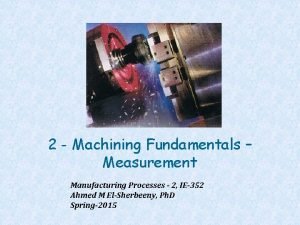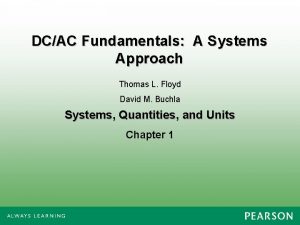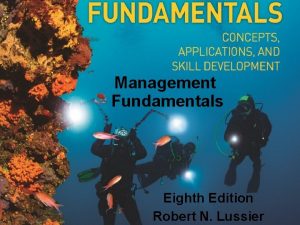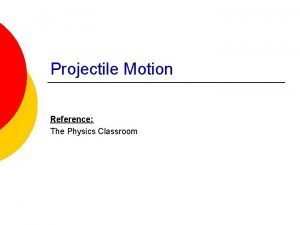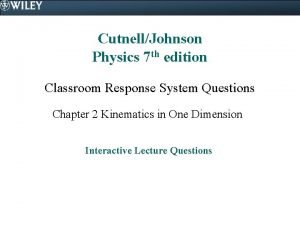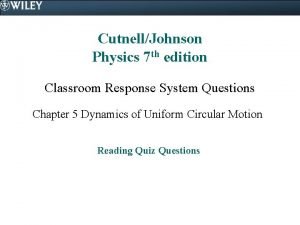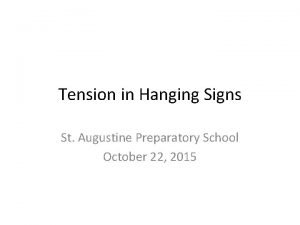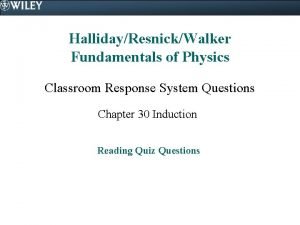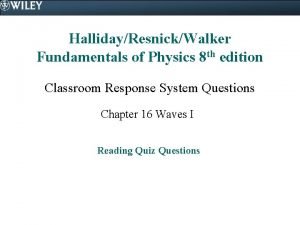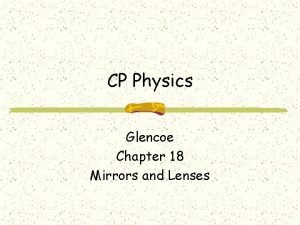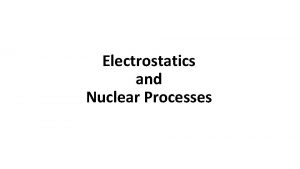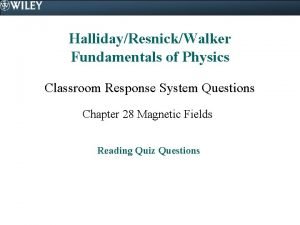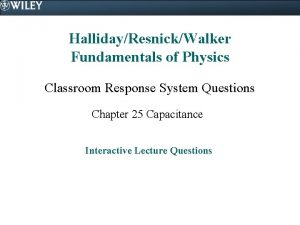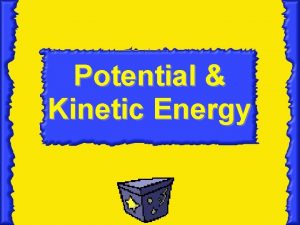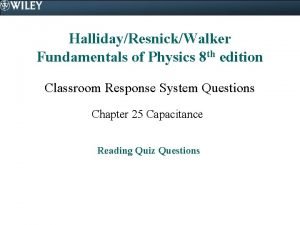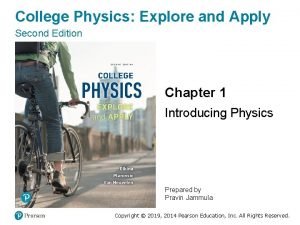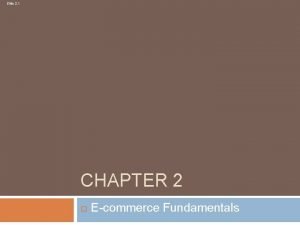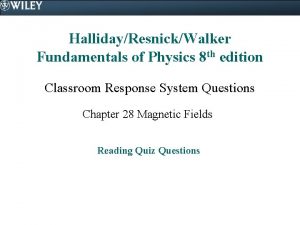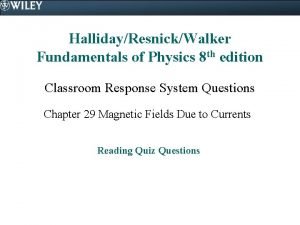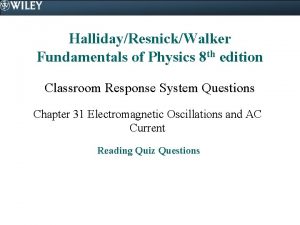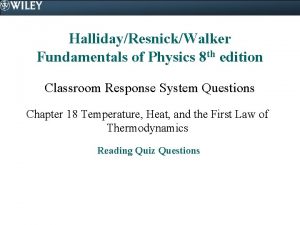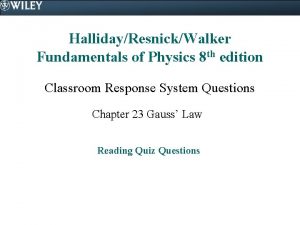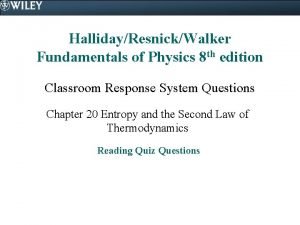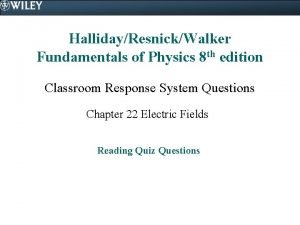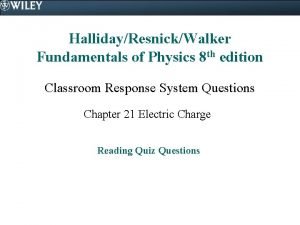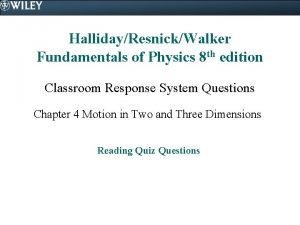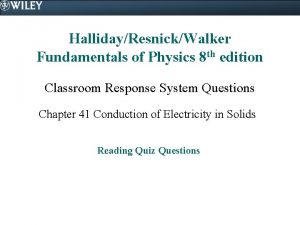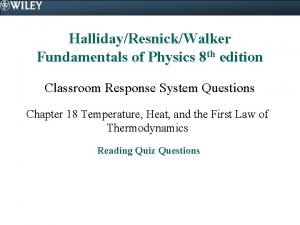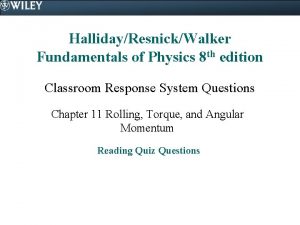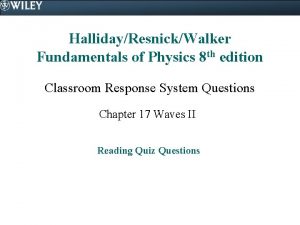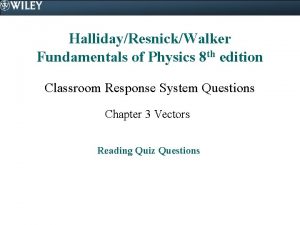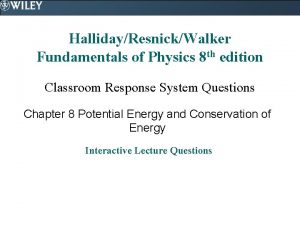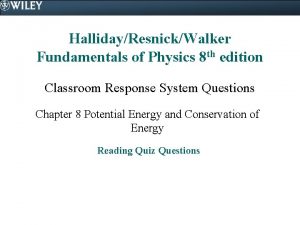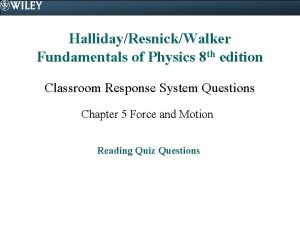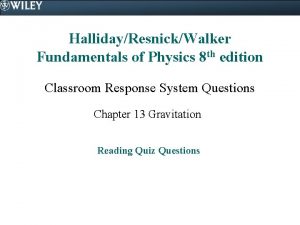HallidayResnickWalker Fundamentals of Physics 8 th edition Classroom















































- Slides: 47

Halliday/Resnick/Walker Fundamentals of Physics 8 th edition Classroom Response System Questions Chapter 26 Current and Resistance Reading Quiz Questions

26. 2. 1. Which of the following corresponds to the units for current? a) N/s b) m/s c) C ∙ m/s d) C/s e) Two or more of the above answers are correct.

26. 2. 1. Which of the following corresponds to the units for current? a) N/s b) m/s c) C ∙ m/s d) C/s e) Two or more of the above answers are correct.

26. 2. 2. Through a certain cross-sectional area of a wire, one coulomb of electrons pass each second. In this case, the current through the wire is equal to which one of the following choices? a) one electron volt b) one volt c) one ampere d) one watt e) one joule per second

26. 2. 2. Through a certain cross-sectional area of a wire, one coulomb of electrons pass each second. In this case, the current through the wire is equal to which one of the following choices? a) one electron volt b) one volt c) one ampere d) one watt e) one joule per second

26. 2. 3. Which one of the following statements concerning the conventional direction of current is true? a) The conventional direction of current is the hypothetical direction of movement of positive charges through the wires of an electric circuit. b) The conventional direction of current is the direction of movement of electrons through the wires of an electric circuit. c) The conventional direction of current is equal to the electromotive force of the battery in an electric circuit. d) The conventional direction of current is always a clockwise movement around a circuit. e) The conventional current is the one that moves in a dc circuit and an unconventional current is one that moves in an ac circuit.

26. 2. 3. Which one of the following statements concerning the conventional direction of current is true? a) The conventional direction of current is the hypothetical direction of movement of positive charges through the wires of an electric circuit. b) The conventional direction of current is the direction of movement of electrons through the wires of an electric circuit. c) The conventional direction of current is equal to the electromotive force of the battery in an electric circuit. d) The conventional direction of current is always a clockwise movement around a circuit. e) The conventional current is the one that moves in a dc circuit and an unconventional current is one that moves in an ac circuit.

26. 2. 4. How is the direction of current flow defined in a conductor? a) It is in the direction of the force on a charged particle. b) It is in the direction that the atoms move. c) It is in the direction that positively-charged particles would move. d) It is in the direction that negatively-charged particles would move. e) It is up to the person doing a given problem to decide the direction.

26. 2. 4. How is the direction of current flow defined in a conductor? a) It is in the direction of the force on a charged particle. b) It is in the direction that the atoms move. c) It is in the direction that positively-charged particles would move. d) It is in the direction that negatively-charged particles would move. e) It is up to the person doing a given problem to decide the direction.

26. 3. 1. Complete the following statement: Current density is a measure of a) the number of charges in a volume at a given time. b) the amount of current flowing through a volume. c) the amount of charges in a cross-sectional area at a given time. d) the amount of current flowing through a cross-sectional area. e) the total mass of the charges through a cross-sectional area.

26. 3. 1. Complete the following statement: Current density is a measure of a) the number of charges in a volume at a given time. b) the amount of current flowing through a volume. c) the amount of charges in a cross-sectional area at a given time. d) the amount of current flowing through a cross-sectional area. e) the total mass of the charges through a cross-sectional area.

26. 3. 2. What is the term used to describe the net motion of electrons when an electric field is applied to a conductor and a current is established? a) drift speed b) random walk c) chaotic velocity d) Brownian acceleration e) Einstein condensation

26. 3. 2. What is the term used to describe the net motion of electrons when an electric field is applied to a conductor and a current is established? a) drift speed b) random walk c) chaotic velocity d) Brownian acceleration e) Einstein condensation

26. 4. 1. Which pair of terms correctly fills the blanks in the following sentence? ____ is a property of an object while ____ is a property of a material. a) resistivity, conductivity b) current, current density c) current, resistance d) resistance, current e) resistance, resistivity

26. 4. 1. Which pair of terms correctly fills the blanks in the following sentence? ____ is a property of an object while ____ is a property of a material. a) resistivity, conductivity b) current, current density c) current, resistance d) resistance, current e) resistance, resistivity

26. 4. 2. In the fabrication of an electrical extension cord, the manufacturer wants to reduce the overall resistance of the wires in the extension cord. Which of the following changes would result in the lowest resistance? a) decrease the diameter of the wires b) increase the diameter of the wires c) choose a metal wire with a larger value of resistivity d) increase the length of the extension cord e) choose a metal with a larger value for the temperature coefficient of resistivity

26. 4. 2. In the fabrication of an electrical extension cord, the manufacturer wants to reduce the overall resistance of the wires in the extension cord. Which of the following changes would result in the lowest resistance? a) decrease the diameter of the wires b) increase the diameter of the wires c) choose a metal wire with a larger value of resistivity d) increase the length of the extension cord e) choose a metal with a larger value for the temperature coefficient of resistivity

26. 4. 3. Two identical resistors are connected in series across the terminals of a battery with a voltage V and a current I flows through the circuit. If one of the resistors is removed from the circuit and the remaining one connected across the terminals of the battery, how much current would flow through the circuit? a) 4 I b) 2 I c) I d) I/2 e) I/4

26. 4. 3. Two identical resistors are connected in series across the terminals of a battery with a voltage V and a current I flows through the circuit. If one of the resistors is removed from the circuit and the remaining one connected across the terminals of the battery, how much current would flow through the circuit? a) 4 I b) 2 I c) I d) I/2 e) I/4

26. 5. 1. Which one of the following statements concerning Ohm’s law is true? a) Ohm’s law is true for all electronic devices. b) Ohm’s law is true when the resistivity of a material is independent of the applied electric field. c) Ohm’s law is true when the resistance varies linearly with the magnitude of the applied electric field. d) Ohm’s law is true for all conductors. e) Ohm’s law is true for all materials.

26. 5. 1. Which one of the following statements concerning Ohm’s law is true? a) Ohm’s law is true for all electronic devices. b) Ohm’s law is true when the resistivity of a material is independent of the applied electric field. c) Ohm’s law is true when the resistance varies linearly with the magnitude of the applied electric field. d) Ohm’s law is true for all conductors. e) Ohm’s law is true for all materials.

26. 5. 2. By which of the following methods could the current in a given circuit be doubled? a) Either double the resistance or double the voltage. b) Reduce either the voltage or the resistance to half of the initial value. c) Either double the voltage or reduce the resistance to half of its initial value. d) Either double the resistance or reduce the voltage to half of its initial value. e) None of the above answers are correct.

26. 5. 2. By which of the following methods could the current in a given circuit be doubled? a) Either double the resistance or double the voltage. b) Reduce either the voltage or the resistance to half of the initial value. c) Either double the voltage or reduce the resistance to half of its initial value. d) Either double the resistance or reduce the voltage to half of its initial value. e) None of the above answers are correct.

26. 5. 3. Which one of the following statements related to Ohm’s law is false? a) The ratio of the voltage applied across a wire to the current flowing through it is constant. b) Resistance is expressed in ohms. c) Georg Simon Ohm discovered the law named after him. d) The resistance of all materials falls within a narrow range of values between 1 and 100 . e) One ohm is equal to one volt divided by one ampere.

26. 5. 3. Which one of the following statements related to Ohm’s law is false? a) The ratio of the voltage applied across a wire to the current flowing through it is constant. b) Resistance is expressed in ohms. c) Georg Simon Ohm discovered the law named after him. d) The resistance of all materials falls within a narrow range of values between 1 and 100 . e) One ohm is equal to one volt divided by one ampere.

26. 5. 4. In most cases, Ohm’s law is valid when which of the following conditions is satisfied? a) when, for a given piece of material, the ratio V/I is the same for a wide range of voltages and currents b) when there is a direct current passing through a given piece of material c) when the voltage across a piece of material is constant for a wide range of currents d) when the current through a piece of material is constant for a wide range of voltages e) when the voltage decreases with increasing current through a piece of material

26. 5. 4. In most cases, Ohm’s law is valid when which of the following conditions is satisfied? a) when, for a given piece of material, the ratio V/I is the same for a wide range of voltages and currents b) when there is a direct current passing through a given piece of material c) when the voltage across a piece of material is constant for a wide range of currents d) when the current through a piece of material is constant for a wide range of voltages e) when the voltage decreases with increasing current through a piece of material

26. 6. 1. What is the name of the microscopic model that may be used to understand why some materials obey Ohm’s law? a) plum pudding model b) Maxwell-Boltzmann model c) standard model d) Anderson model e) free-electron model

26. 6. 1. What is the name of the microscopic model that may be used to understand why some materials obey Ohm’s law? a) plum pudding model b) Maxwell-Boltzmann model c) standard model d) Anderson model e) free-electron model

26. 7. 1. The SI unit of power is the watt. Which of the following units are equivalent to the watt? a) V∙A b) J/C c) C/s d) V/s e) A/s

26. 7. 1. The SI unit of power is the watt. Which of the following units are equivalent to the watt? a) V∙A b) J/C c) C/s d) V/s e) A/s

26. 7. 2. In the equation, P = i 2 R, what is the meaning of the variable P? a) It refers to total power dissipated by the circuit. b) It refers to the transformation of electric potential energy into thermal energy. c) It refers to the transformation of electric potential energy into mechanical energy. d) It refers to the power of a resistor. e) It refers to the probability that Ohm’s law will be obeyed by the resistor in a circuit.

26. 7. 2. In the equation, P = i 2 R, what is the meaning of the variable P? a) It refers to total power dissipated by the circuit. b) It refers to the transformation of electric potential energy into thermal energy. c) It refers to the transformation of electric potential energy into mechanical energy. d) It refers to the power of a resistor. e) It refers to the probability that Ohm’s law will be obeyed by the resistor in a circuit.

26. 7. 3. Complete the following sentence: The SI unit for electric power is a) kilowatt-hour. b) light-year. c) watt. d) joule. e) farad.

26. 7. 3. Complete the following sentence: The SI unit for electric power is a) kilowatt-hour. b) light-year. c) watt. d) joule. e) farad.

26. 7. 4. Which one of the following equations is not a valid expression for electric power P? Note: I is the current in a circuit as a result of a voltage V and R is the electrical resistance of the circuit. a) P = I 2 R b) P = c) P = IV d) P =

26. 7. 4. Which one of the following equations is not a valid expression for electric power P? Note: I is the current in a circuit as a result of a voltage V and R is the electrical resistance of the circuit. a) P = I 2 R b) P = c) P = IV d) P =

26. 8. 1. Complete the following sentence: the electrical resistivity of most metal wires is a) constant, even when the temperature of the metals varies greatly. b) independent of the length of the wire. c) expressed in ohms. d) much smaller than the values for most semiconductors. e) inversely proportional to the cross-sectional area of the wire.

26. 8. 1. Complete the following sentence: the electrical resistivity of most metal wires is a) constant, even when the temperature of the metals varies greatly. b) independent of the length of the wire. c) expressed in ohms. d) much smaller than the values for most semiconductors. e) inversely proportional to the cross-sectional area of the wire.

26. 8. 2. Which one of the following types of materials exhibits the largest values of resistivity? a) insulators b) semiconductors c) superconductors d) metals

26. 8. 2. Which one of the following types of materials exhibits the largest values of resistivity? a) insulators b) semiconductors c) superconductors d) metals

26. 8. 3. To make silicon useful for electronic circuits, impurity atoms must be added. What is the name of this process? a) implementation b) superposition c) doping d) seeding e) sintering

26. 8. 3. To make silicon useful for electronic circuits, impurity atoms must be added. What is the name of this process? a) implementation b) superposition c) doping d) seeding e) sintering

26. 9. 1. What kind of materials exhibit zero resistivity when the temperature is reduced below a critical temperature for that material? a) semiconductors b) piezoelectrics c) ferroelectrics d) perovskites e) superconductors

26. 9. 1. What kind of materials exhibit zero resistivity when the temperature is reduced below a critical temperature for that material? a) semiconductors b) piezoelectrics c) ferroelectrics d) perovskites e) superconductors

26. 9. 2. What happened in the field of superconductivity in 1986? a) A material that is superconducting at room temperature was discovered. b) Ceramic materials were found that are superconducting at much higher temperatures than metals or alloys. c) High efficiency cooling methods were found that substantially reduced the costs of cooling materials to the superconducting state. d) Superconductivity was observed for the first time in organic materials. e) The first superconducting magnet was invented.

26. 9. 2. What happened in the field of superconductivity in 1986? a) A material that is superconducting at room temperature was discovered. b) Ceramic materials were found that are superconducting at much higher temperatures than metals or alloys. c) High efficiency cooling methods were found that substantially reduced the costs of cooling materials to the superconducting state. d) Superconductivity was observed for the first time in organic materials. e) The first superconducting magnet was invented.
 University physics with modern physics fifteenth edition
University physics with modern physics fifteenth edition Fundamentals of information systems 9th edition
Fundamentals of information systems 9th edition Fundamentals of information systems 9th edition
Fundamentals of information systems 9th edition Fluid mechanics fundamentals and applications
Fluid mechanics fundamentals and applications Floyd digital fundamentals
Floyd digital fundamentals Machining fundamentals 10th edition
Machining fundamentals 10th edition Fundamentals of organizational communication 9th edition
Fundamentals of organizational communication 9th edition Fundamentals of organizational communication 9th edition
Fundamentals of organizational communication 9th edition Sujata madan
Sujata madan Floyd digital fundamentals ppt
Floyd digital fundamentals ppt Floyd digital fundamentals 10th edition pdf
Floyd digital fundamentals 10th edition pdf Dc/ac fundamentals a systems approach
Dc/ac fundamentals a systems approach Computer security fundamentals 4th edition
Computer security fundamentals 4th edition Management fundamentals 8th edition
Management fundamentals 8th edition Fundamentals of information systems
Fundamentals of information systems Fundamentals of corporate finance canadian edition
Fundamentals of corporate finance canadian edition Fundamentals of corporate finance fifth edition
Fundamentals of corporate finance fifth edition Corporate finance 6th edition
Corporate finance 6th edition Fundamentals of abnormal psychology ninth edition
Fundamentals of abnormal psychology ninth edition Fundamentals of information systems 9th edition
Fundamentals of information systems 9th edition Thermal conduction resistance
Thermal conduction resistance The fundamentals of political science research 2nd edition
The fundamentals of political science research 2nd edition Smart classroom vs traditional classroom
Smart classroom vs traditional classroom Using mis 10th edition
Using mis 10th edition Chapter 1
Chapter 1 Physics classroom projectile motion
Physics classroom projectile motion Physics classroom
Physics classroom Centripetal acceleration physics classroom
Centripetal acceleration physics classroom Physics hanging sign problem
Physics hanging sign problem Unit of flux
Unit of flux Circular functions
Circular functions Physics classroom lenses and mirrors
Physics classroom lenses and mirrors Electrostatics physics classroom
Electrostatics physics classroom Gauss law physics classroom
Gauss law physics classroom Physics classroom magnetic field
Physics classroom magnetic field Capacitance physics classroom
Capacitance physics classroom Physics classroom kinetic energy
Physics classroom kinetic energy Capacitance physics classroom
Capacitance physics classroom College physics: explore and apply answers
College physics: explore and apply answers Modern physics vs classical physics
Modern physics vs classical physics Ib physics hl ia examples
Ib physics hl ia examples Certification in hotel industry analytics
Certification in hotel industry analytics Water treatment fundamentals
Water treatment fundamentals Take charge today the fundamentals of investing
Take charge today the fundamentals of investing Fundamentals of ecommerce
Fundamentals of ecommerce Basic networking fundamentals
Basic networking fundamentals Security guide to network security fundamentals
Security guide to network security fundamentals Financial investment analysis
Financial investment analysis





